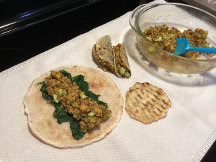 |
| Organic Quinoa: Ivory, Red & White, Tri-Color |
'Quinoa' (pronounced keen-waa) was a staple in the diet of the ancient Incas. It is a whole grain that is now rapidly growing in popularity due to its many health benefits.
Quinoa is a flowering plant of the amaranth family. It is an annual plant grown as a crop primarily for its edible seeds. Though technically a seed, Quinoa is classified as a whole grain and is a good source of plant protein and fiber. It is a gluten-free, whole grain carbohydrate, as well as a whole protein, meaning it contains all nine essential amino acids. Quinoa cooks up much faster than other grains and when cooked the seeds expand rapidly, become tender but chewy and expel spirals that give a slight crunch. Cooked Quinoa becomes light, fluffy and nutty; the ideal canvas to showcase intense flavors, rich textures and your favorite veg, meats, dressings and sauces. Plus it provides 8 grams of protein, 5 grams of fiber and 220 calories per every 1 cup cooked. Over all it has 3-4 times more nutrients than brown rice. It is light and fluffy in texture but has the 'whole grain' ability to fill you up.
It comes in different varieties with different colors as well ... with white, red and black being most common. Most stores carry the common white quinoa but I found the color mixtures also available in a mix of red and white and a mixture of three colors at our local grocery stores.
- White Quinoa is the most readily available and is labeled simply Quinoa or sometimes Ivory Quinoa. It is very light and fluffy and the least bitter of the three.
- Red Quinoa tastes like white but when cooked remains slightly more al dente, therefore has a bit more chewy texture and holds its shape better in cold salads.
- Black Quinoa is harder to find but like red quinoa maintains its shape better than white when cooked and it tastes nuttier.
- Tri-Color Quinoa as the name suggests is a mixture of white, red and black into one bag.
Quinoa has a bitter, unappetizing coating called 'saponin' which occurs naturally as it grows to protect it from being eaten by wildlife. There is an easy 'fix' to removing this bitter, soapy flavor of the saponin coating ... by rinsing the quinoa grains thoroughly in cold water before cooking in any method. To do this, use a fine mesh sieve so you don't lose any of the tiny grains down the drain. Let the cold water run over the grains shaking the sieve and using your hand to move them around so all the grains get a good rinse.
.jpeg) |
| Stove-top Quinoa with Curry |
How to Cook Quinoa in a Rice Cooker - rinse the quinoa thoroughly. Grease the inside of the rice cooker with butter or cooking spray. Add 2 cups liquid to 1 cup quinoa and turn the rice cooker to the white rice setting. When the rice cooker lets you know the cycle is complete, open it and fluff the quinoa with a fork. Unlike rice the quinoa cannot remain in the rice cooker on 'keep warm', it will go mushy. So, remove the cooked quinoa from the rice cooker right away.
How to Cook Quinoa in an Instant Pot - *NOTE: this method is the exception and uses equal portions of liquid to quinoa. Rinse the quinoa thoroughly. Grease the inside of the IP with butter or cooking spray. Add quinoa and liquid in the ratio of 1 cup liquid to 1 cup quinoa. Close and lock the lid, set the cook time for 1 minute. Allow the steam to release naturally. Open the IP, fluff the quinoa and remove from the IP right away.
 |
| Curried Quinoa Wraps |
Until next time ... Bon Appétit!
Photos by Sally RaeCooking method research from The Food Network
Yummmm!! I love keen-wa HeeHee
ReplyDeleteYou're funny. And, best-of-all, yoo Neye can definitely have a lot moe!
keen-wa for the impossible length
N breadth of eternity Upstairs, lil1.
We can live on that if you wanna!!!
Follow me2theWeddingFeastASAP:
● NOPEcantELOPE.blogspot.com ●
Cya soon, miss adorable girl...